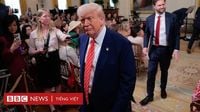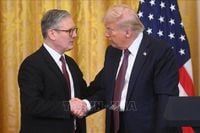On February 27, 2025, U.S. President Donald Trump met with British Prime Minister Keir Starmer in Washington D.C., marking a significant moment in U.S.-UK relations. The meeting culminated in a trade agreement announced on May 8, 2025, which has been hailed as a breakthrough for both nations. Trump praised the deal, emphasizing the UK's status as one of America's key allies, while Starmer highlighted the historic importance of finalizing the agreement after years of negotiations.
The newly established agreement allows British steel and aluminum exports to enter the U.S. at a 0% tax rate. Furthermore, automobile exports from the UK will be subject to a quota of 100,000 vehicles per year, taxed at a significantly reduced rate of 10%, down from the previous 27.5%. This is seen as a major victory for both industries, which have been heavily impacted by U.S. tariffs.
Washington's car tariff quota for London represents 80% of the UK's total automobile exports to the U.S. annually. Additionally, the British steel industry, which sells approximately 200,000 tons of steel worth 400 million pounds (about 532 million USD) to the U.S. each year, stands to benefit from this agreement.
In exchange, the UK has abolished tariffs on U.S. ethanol and agreed to reciprocal market access for beef, allowing farmers from both countries to export 13,000 tons of duty-free meat to each other annually. However, both nations have provided scant details about the agreement, indicating that further negotiations on tax reductions in key areas are ongoing.
Analysts suggest that the White House's negotiations with the UK reflect a strategy of targeting specific industries to extract concessions from partners during talks. For the UK, the focus has been on agriculture, automobiles, and steel—areas where they secured specific tax exemptions and commitments for preferential treatment in future tariff rounds.
Interestingly, the negotiations have sidestepped long-standing disputes, such as the UK's digital services tax affecting major tech companies and stringent food standards, including the ban on chlorine-washed chicken imports. Instead, both sides are expected to negotiate separate agreements for sectors like steel and aluminum, digital trade, and pharmaceuticals.
Despite being a significant step forward, the UK did not secure any concessions from the White House regarding the general 10% import tax on most goods. This means that, while the agreement mitigates some of the damages from the tariff war, British goods still face higher tariffs than they did prior to what has been termed "Liberation Day," the day Trump announced reciprocal tariffs.
According to Anna Titareva, an economist at UBS, the deal reduces tariffs for the UK to 9.1% from 11.6%, yet this is still significantly higher than the approximately 1% rate that existed before "Liberation Day" on April 2, 2025. UK officials have acknowledged that the agreement does not fulfill expectations of becoming a comprehensive free trade agreement in the post-Brexit era, but they remain hopeful that it will pave the way for further negotiations, including potential reductions on specific UK exports.
British Ambassador to the U.S. Peter Mandelson referred to the agreement as a "stepping stone" toward further liberalization. However, Trump's messaging was somewhat ambiguous, stating that while the deal would continue to "expand," it had also "reached its maximum level." Most analysts agree that the tangible benefits of the agreement are limited, despite nearly a decade of trade negotiations.
Stan Veuger, a senior fellow at the American Enterprise Institute, described the scope of the negotiations as narrow, suggesting that both countries have essentially maintained the status quo, making only minor adjustments and branding them as an agreement. During his first term, Trump similarly declared victories in agreements with China, Mexico, and Canada, which experts argue had minimal actual impact.
The Bank of England (BoE) forecasts a slowdown in UK economic growth, not primarily due to the tariffs on the UK but rather due to the broader impact of Trump's trade policies on global growth. In essence, the removal of tariffs on the UK as part of this deal may have little direct impact on the UK economy, as the key industries involved account for less than 30% of UK goods exports to the U.S. and less than 1% of GDP.
However, as an open economy, the UK will likely feel adverse effects from the spillover impacts of tariffs imposed on other U.S. trading partners, such as the European Union (EU), which is the UK's largest trading partner, accounting for 41.4% of UK exports and 51.5% of UK imports.
Despite these challenges, the agreement could help stabilize the economy by alleviating some uncertainties identified by the BoE as factors undermining business and consumer confidence. It may also serve as a reference model for negotiations with other U.S. trading partners, including India, Japan, and South Korea, which are believed to be close to reaching agreements with Washington, signaling to U.S. partners that Trump's tough tariff rhetoric may be negotiable with the right diplomatic approach.
Nonetheless, analysts caution that if the so-called "special relationship" with the UK yields only minor concessions, countries with significant trade surpluses with the U.S. may have little reason to expect favorable outcomes.
In the financial markets, the U.S. dollar continued to strengthen against major currencies, buoyed by optimism following the completion of the U.S.-UK trade agreement. On May 9, 2025, the USD recorded a week of price increases against currencies such as the Swiss franc, Japanese yen, and euro. The dollar's upward trend was attributed largely to market optimism surrounding the trade agreement and upcoming U.S.-China trade negotiations.
On that day, the USD experienced its fourth consecutive week of gains against the Swiss franc, despite a slight decrease of 0.01% to 0.83150 USD/franc. The euro, meanwhile, faced its third week of losses against the dollar, despite a 0.17% increase on May 9, reaching 1.125025 euro/USD. The USD also recorded its third week of gains against the Japanese yen, though it fell by 0.39% to 145.355 USD/yen during the final trading session.
In contrast, the British pound (GBP) ended the week positively, closing up 0.5% at an exchange rate of 1.3306 USD/GBP. The dollar did see a slight decrease against some Asian currencies, including a 0.02% drop against the Chinese yuan on May 9, though it still recorded a weekly increase.
As the financial world watched closely, Bitcoin surged past the 100,000 USD/BTC mark, rising more than 0.38% to 103,023.28 USD/BTC on May 9, 2025. Market attention is now shifting toward the forthcoming U.S.-China trade negotiations set to begin on May 10 in Switzerland.
Matthew Weller, head of market research at StoneX, noted that market sentiment is optimistic regarding progress in U.S.-China trade talks, as well as the potential for various other trade agreements. He suggested that the Trump administration seems to be signaling positive developments regarding tariffs for different countries, indicating that the worst phase of the tariff war may be behind us. This could represent a turning point in how markets begin to price in future trade dynamics.


